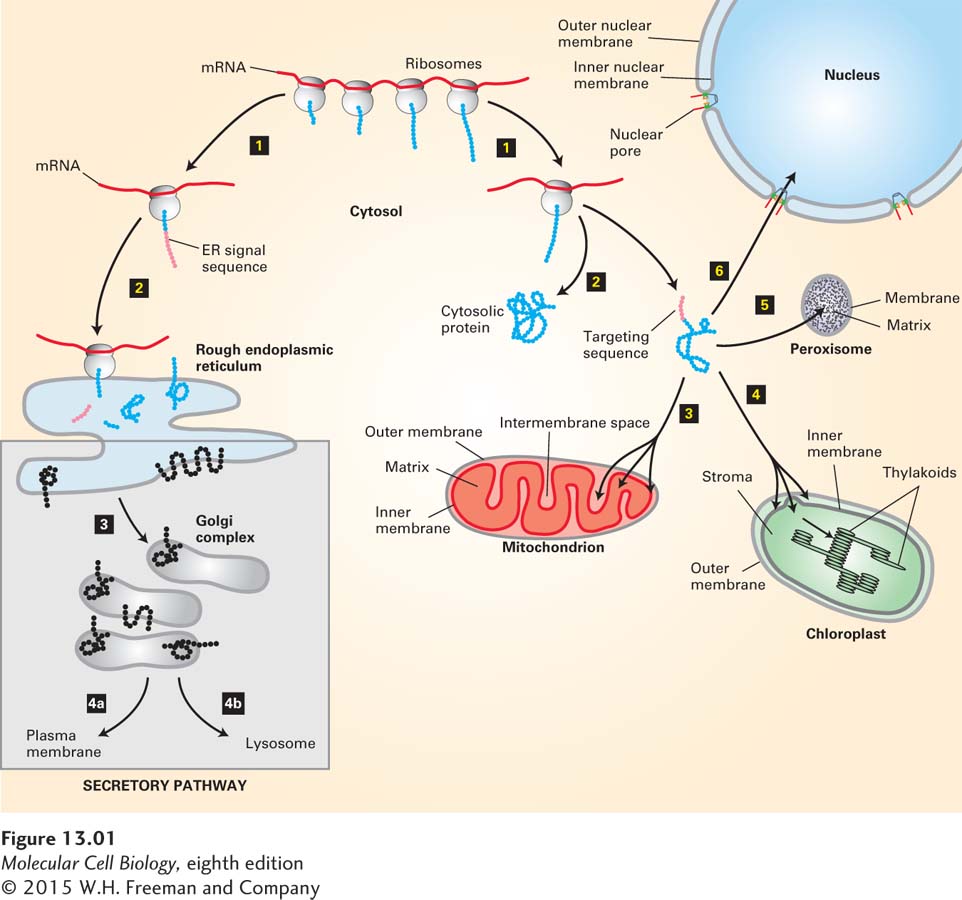Image Test For Keri
The delivery of newly synthesized proteins to their proper cellular destinations, usually referred to as protein targeting or protein sorting, encompasses two very different kinds of processes: signal-based targeting and vesicle-based trafficking. The first kind of process involves the targeting of a newly synthesized protein from the cytoplasm to an intracellular organelle. Targeting can occur during translation or soon after synthesis of the protein is complete. For membrane proteins, targeting leads to insertion of the protein into the lipid bilayer of the membrane, whereas for water-soluble proteins, targeting leads to translocation of the entire protein across the membrane into the aqueous interior of the organelle. Proteins are sorted to the endoplasmic reticulum (ER), mitochondria, chloroplasts, peroxisomes, and nucleus by this general process (Figure 13-1).

FIGURE 13-1 Overview of major protein-sorting pathways in eukaryotes. All nuclear DNA–encoded mRNAs are translated on cytosolic ribosomes. Right (nonsecretory pathways): Synthesis of proteins lacking an ER signal sequence is completed on free ribosomes (step 1). Those proteins that contain no targeting sequence are released into the cytosol and remain there (step 2). Proteins with an organelle-specific targeting sequence (pink) are first released into the cytosol (step 2) but are then imported into mitochondria, chloroplasts, peroxisomes, or the nucleus (steps 3–6). Mitochondrial and chloroplast proteins typically pass through the outer and inner membranes to enter the matrix or stromal space, respectively. Other proteins are sorted to other subcompartments of these organelles by additional sorting steps. Nuclear proteins enter and exit through visible pores in the nuclear envelope. Left (secretory pathway): Ribosomes synthesizing nascent proteins in the secretory pathway are directed to the rough endoplasmic reticulum (ER) by an ER signal sequence (pink; steps 1 and 2). After translation is completed on the ER, these proteins can move via transport vesicles to the Golgi complex (step 3). Further sorting delivers proteins either to the plasma membrane or to lysosomes (step 4a or 4b). The vesicle-based processes underlying the secretory pathway (steps 3 and 4, shaded box) are discussed in Chapter 14.
The second general sorting process, known as the secretory pathway, involves transport of proteins from the ER to their final destination within membrane-enclosed vesicles. For many proteins, including those that make up the extracellular matrix, the final destination is the outside of the cell (hence the name); integral membrane proteins are also transported to the Golgi complex, lysosomes, and plasma membrane by this process. The secretory pathway begins in the ER; thus all proteins slated to enter the secretory pathway are initially targeted to this organelle.
